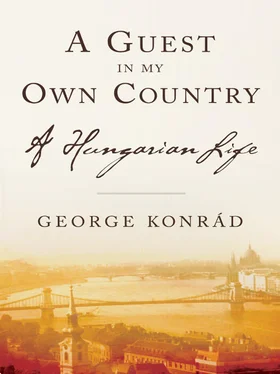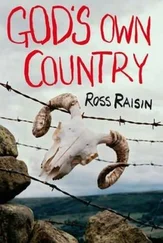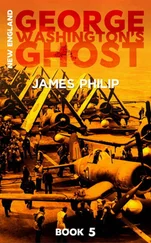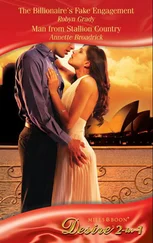In 1949 I did not know much about what was going on in the cellar, but from the BBC I learned that the accused in show trials would say all sorts of things to incriminate themselves, that they were mere puppets, their will having been broken with beatings and chemicals. This seemed plausible, as they spoke like automatons, reciting more than repenting, as if meaning no longer mattered.
The cameraman father of a boy I knew told his son that the proceedings were filmed without the knowledge of the accused. Moreover, the trial was staged more than once, and the accused never knew which the “real” one was. The final film version was spliced together from several takes. Could the whole procedure have been just for the sake of the film? The director supposedly had friends among the accused.
A bit further up Andrássy (soon to be Stalin) Boulevard there was a private lending library that was taken over by the state in 1949. It was intoxicating for me, at fifteen, to take out novels by Steinbeck, Hemingway, Martin du Gard, and Malraux. The same neighborhood also boasted a respectable private house of assignation run by Madame Clarisse on the second floor of a neoclassical apartment building. By the end of the year it was all over: the private library, the private maison de rendezvous , and everything else private, including the private individual. Nor were we left in peace at school: we had to sing hymns of praise to the working class after each ten-minute break. Sometimes we slipped in a dirty rhyme or two.
When in the early sixties the State Security Agency moved out and the space reopened as Specialty Pastries, I would drop in after long afternoons spent investigating the living conditions of people on file at the Public Welfare Authority. I would sit with friends in velvet-upholstered chairs beneath the chandeliers’ gold curlicues and Venetian glass and surrounded by blue-silk walls and gold-leaf friezes as trolley buses, the pride of Soviet technology, rumbled by. I was always on good terms with the old ladies in the cloakroom. I had many dates there, dates with beautiful women and odd women, with clever women and madwomen: I had just divorced my first wife. Those women are dead by now, or elderly.
Late in November 1983, when I was on a fellowship at the New York Institute for the Humanities, my wife Jutka and I rented an apartment on the corner of Fourth Street and Avenue A, four blocks from St. Mark’s Place. One morning while walking along the latter we came upon a street fair. There were bands playing and a woman prancing around on stilts, enticing children to dance. We bought a table lamp for two dollars, and the seller wanted to prove to us it worked. We walked into a precinct house to look for an outlet. “Your honor is at stake,” the policemen told him, smiling as they pointed to an outlet. The lamp did not light. They had a good laugh, black and white, men and women alike — then took pity on the salesman and pointed him to a working outlet. The lamp was fine. Filled with a sense of dignity, the salesman then told us that his mother was Hungarian and that he was happy to have us here in this part of town, properly called the East Village, not the Lower East Side.
I am standing at a Tarot reader’s shop front surrounded by iron pipes, iron plates, and iron gratings. The mustachioed old fortune-teller likes to snooze in a rickety armchair in the window. The next two shops are bookshops. My novel The Loser is available in both. Back home it had to be published in the utmost secrecy, which bestowed an aura of heroic transgression on the publisher, Gábor Demszky. Here in America I ran into a samizdat plain-white-cover edition. It is so tightly spaced that the whole novel fits into two hundred pages instead of four.
Iván Szelényi and I also single-spaced our typescript of The Intellectuals on the Road to Class Power . The fewer the pages, the easier it was to smuggle it outside the country. That accomplished, I could turn back to my novel. But one day Biki (Tibor Hajas — poet, essayist, photographer, body-artist, film director, watchman, and warehouse worker) told us there had been a house search at Tamás’s (Tamás Szentjóby — poet, painter, film actor, and Fluxus artist). They had been looking for pornography, but discovered our manuscript instead. They suddenly lost all interest in pornography. No, they had a 132-page typescript dealing with ideological issues and containing all sorts of seditious ideas. “Looks like 127/b is your genre: incitement against the state,” said the good-humored, portly lieutenant colonel entrusted with my arrest and interrogation.
Now here we were, nearly ten years later, our consternation having shriveled to a series of comical anecdotes, standing in St. Mark’s Place, looking over the offerings on the sidewalk. People put out anything with the slightest chance of selling, trusting to the market gods to make the proper match. Nor did the market gods let them down. For among the pulp novels and one or two good books were two familiar-looking soft-cover volumes — red on top, yellow underneath — with a Hungarian title: Társadalmi Szemle (Review of Society), the theoretical journal of the Hungarian Communist Party, November and December, 1949. Stalin, then celebrating his seventieth birthday, was on the cover.
I picked up one of the yellowed volumes. Now the young black man proffering it was certain you could find a paying customer for anything under the sun. Supine on a New York sidewalk the generalissimus was none too imposing, but in the autumn of 1949 the whole world was sending him gifts, including a trainload assembled by the grateful Hungarian People with enough material — a sea of miniature locomotives, machine tools, and children’s drawings — for an exhibition. What is more, there was a statue of him in every shopwindow. In butcher shops, for example, the wisest leader in the history of mankind was rendered in frozen lard, the artist’s honorarium being paid in kind: fatback.
Suddenly there was a vacant flat on the first floor of the Andrássy Boulevard building. Its former inhabitant was the son-in-law of the President of the Republic, a self-assured squat little man with an equally self-assured and squat spouse. In the autumn of 1949 the shutters were rolled down. The son-in-law of the President of the Republic had been appointed ambassador to Cairo and moved there with his family. Then he was ordered home, denounced as a spy, condemned to death, and executed. It didn’t take long. The large American car stopped coming for his wife. The movers came and took all their possessions heaven only knows where.
The year 1949 was the year of the Great Change, the great new rigor, as peace-loving, progressive mankind prepared for the seventieth birthday of the Lighthouse of the Peoples. The brass band of the Hungarian State Security Agency, as part of peace-loving and progressive mankind, had recently moved into the spacious apartment of the freshly executed Hungarian ambassador to Cairo, and there they rehearsed the Stalin Cantata . I was forced to listen: I lived on the opposite side of the courtyard. They rehearsed it bar by bar, playing each one hundreds of times, boring it into my head. “Stalin is our battle, Stalin is our peace, and the name of Sta-a-a-lin will make the world a better place.” (The last line had slight meter and rhyme problems, but was ideologically pure.) Sometimes a booming chorus would sing along. It was all very festive.
In 1949 Stalin thought there would be a war with the West, so the eastern half of Europe needed to be unified according to the Soviet model. The Soviet model meant trials. They started by sentencing Archbishop József Mindszenty to life. Then came the tall, handsome, and popular Foreign Minister (previously Minister of the Interior) László Rajk, who was selected for the role of arch criminal and duly tortured until he testified against himself. The BBC called him a victim of the very methods he had introduced.
Читать дальше












